
8 minute read
Need a Lift?
LIFT?

EZ Dock
Boat lifts of today are sleek, multipurpose, and focus on both form and function.

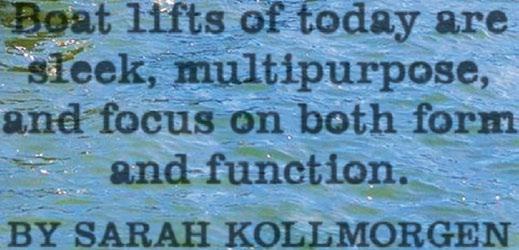
BY SARAH KOLLMORGEN
Not all of today’s manufacturers work in such extreme applications, however. EZ Dock’s EZ Kayak Launch is made specifically for those looking to easily get in and out of the water from their kayak or canoe. The one-piece design features built-in paddle notches so beginners and advanced kayakers alike can launch and dock with ease.
For HydroHoist, which has headquarters in Claremont, Oklahoma, and operates internationally, versatility involves more than accommodating a range of different boats; the lifts themselves must be multipurpose. Take the company’s new HarborHoist lift. It’s a free-floating lift that allows boaters to tie it to the dock with ropes or use a conventional mooring system. It’s also designed to operate in saltwater, brackish water and freshwater. Not only does the HarborHoist work in most slip configurations, it can accommodate most boat styles, such as pontoons, tritoons, wake, inboard and V-hull, and is capable of lifting 25,000 pounds.
“It’s definitely the most flexible, most user-friendly lift we have,” says Mick Webber, CEO at HydroHoist. “It allows us to operate anywhere in the world.”
Ease of use Perhaps the greatest driver of innovation in lifts is ease of use. Whether through accessories or the structure of the lift itself, many manufacturers are looking for ways to make lifts as easy as possible to operate.
Consider the growing popularity of floating boat lifts. A report by Zion Market Research predicts that the global market for floating docks and drive-on boat lifts will reach $470 million by 2024. These floating lifts are made up of lightweight, durable and modular pieces that literally float on top of the water, making them ideal for both deep and shallow water applications. They are simple to operate and easy to step on and off.
Jet Dock is a Cleveland, Ohio-based company that specializes in a wide range of floating boat lifts and drive-on docking systems. Jet Dock claims that floating docks are easier to maintain and customize as your boating needs change due to their modular design. You can find a floating lift from Jet Dock for just about any application, too: Kayaks, PWC — these floating Lego-like docks even hold pontoons. Most of Jet Dock’s floating lifts are completely electricity free — you simply drive your boat up on the lift and you’re done.
For Binger, it’s this simplicity that customers are looking for. While Bulmann Dock and Lift does not produce floating lifts, they focus on creating designs that are incredibly easy to use regardless of boating experience.
“It’s all about convenience, being

HydroHoist
Golden Boat Lifts
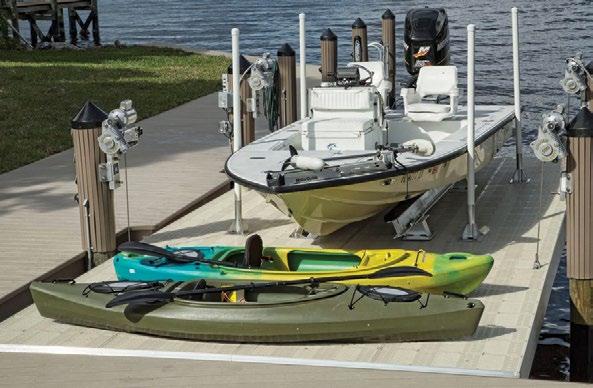
Some lifts, like the Bulmann Dock and Lift (opposite, top left), are more standard, while others, like the HydroHoist (this page, top) and Jet Dock (opposite, top right), provide boaters a fl oating lift that can fl uctuate with water levels. Other lifts, like the Golden Boat Lifts (above) and No Profi le Boat Lifts (opposite, bottom right) offer more sleek, streamlined solutions. The SunStream SwiftShield cover (opposite, bottom left) is a great solution to quickly cover your prized possession.
simple and working when you need it to,” Binger says.
While you might think this means more tech and more gadgets, Binger says that’s not always the case. In fact, he says that at Bulmann Dock and Lift they’ve noticed a considerable percentage of customers opting for more manual, less tech-heavy lifts.
“They go with the tried and true versions,” he says.
Gadgets galore But just because a lift is easy to use doesn’t mean it can’t have fun gadgets and accessories! Webber considers remotecontrol capabilities to be one of the biggest trends in lift innovation today. At HydroHoist, Webber says they’re working on Bluetooth enhancements in its lift control boxes. He thinks lifts can be more user-friendly if they incorporate technology that we are already using in our daily lives.
“Customers want the ability to use their phone to control their hoist when they’re not right in front of it, maybe as they’re walking down the dock,” he says.
Depending on where you look, you can find lifts that boast solar panels, remotecontrol capabilities and other gizmos. However, one of the most in-demand accessories on the market today, according to Webber and Binger, are canopies.
“[Boaters] want to pull into the canopy and have it completely protect their boat,” Binger says. “Boats are such an investment; it’s all about protecting that investment.”
Bulmann Dock and Lift produces two types of canopies: A standard canopy
and a high-rise canopy for high-profile boats, such as those with board towers, radar arches, Bimini tops and center consoles. Bulmann Dock and Lift uses TOP GUN fabrics, which are designed to keep boats protected in both rain and shine. As an added bonus, Bulmann Dock and Lift’s canopies come in more than a dozen colors.
SunStream is another lift company with accessories on its mind. While SunStream has pioneered hydraulic, solar and remote-controlled boat lifts for years, the company’s semi- and fully-automatic boat covers, called the SwiftShield, are proving a popular, effortless way to cover your boat without breaking a sweat.
Aesthetics Versatility, ease of use and new technology innovations are all nice. But sometimes, you’ve got to think about style.
“Form is very important now,” Webber says. “We need to move away from form being utilitarian and make it more pleasing to the eye.”
To that end, Webber says HydroHoist follows the saying, “Fit, form and function” in developing all products. They aren’t the only ones; several lift manufacturers are looking into ways to make lifts not only user-friendly, but also aesthetically pleasing.
No Profile Boat Lifts by Way Marine Design takes this to heart. This company’s “invisible” boat lifts conceal all mechanical gear, metal beams and wiring to create a sleek, sophisticated design that allows users to simply walk up to and onto their boat without stepping over any parts. No Profile Boat Lifts has several designs: The Deuce platform lift can accommodate multiple vessels on a single platform, while the Cradle Lifts use catwalks in a minimalist design. All No Profile Boat Lifts use hydraulic power.
Buying a boat is a big investment. Thanks to recent innovations in boat lifts, there are more choices than ever to find a lift that not only protects that investment, but fits your boating lifestyle, environment and stylistic preferences. ★
Bulmann Dock and Lift

SunStream SwiftShield cover Jet Dock

No Profi le Boat Lifts
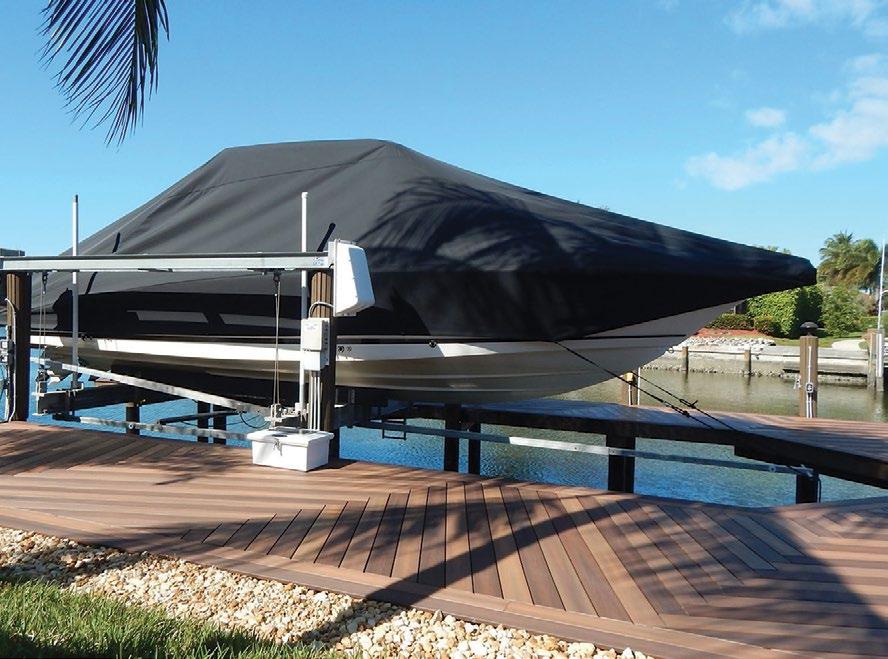
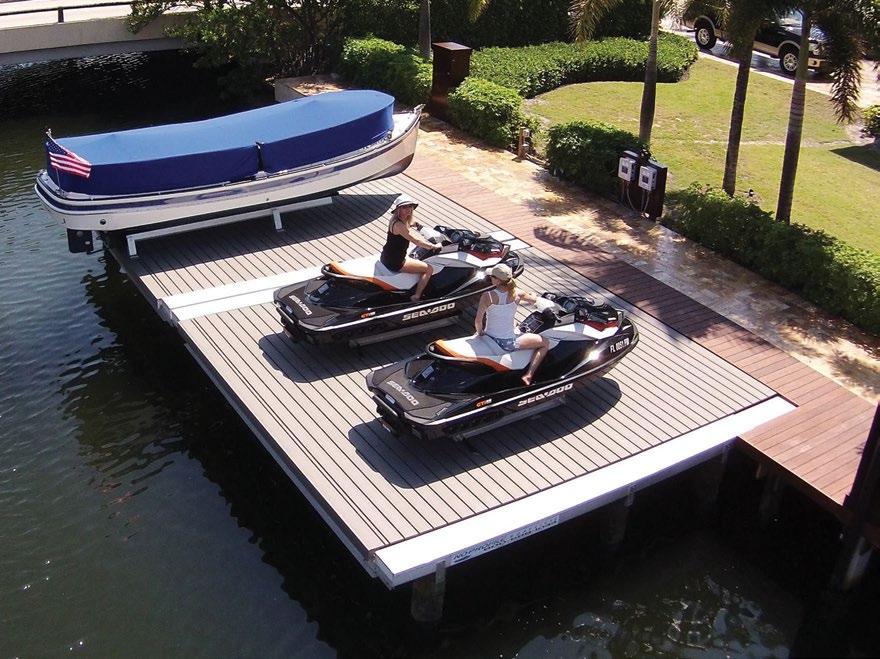
ANCHORING 1 1




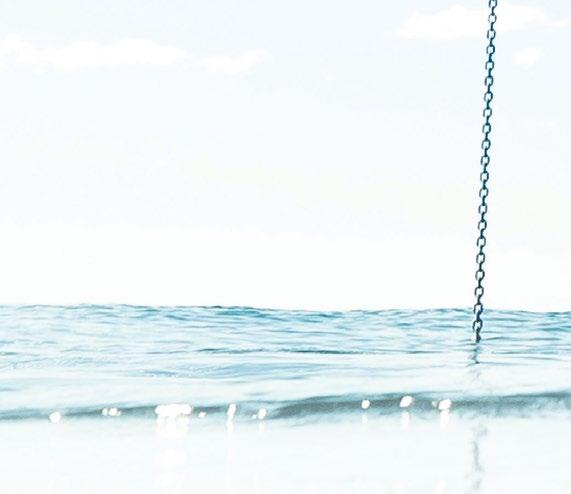
A beginner’s guide to the art of anchoring.
BY FELICIA SCHNEIDERHAN

So, you want to try anchoring?” my husband,
Mark, asks me.
In more than a decade of boat life, never once had I stood at the bow and let the anchor down. This was Mark’s job. I liked to be at the helm, following his direction to steer the boat to port or starboard, keeping on eye on the depth and the other boats anchored around us.
But on this day, a gorgeous, calm day at Sand Island in Wisconsin’s Apostle Islands, I say, “Sure.”
I stand at the bow, ready to launch our Bruce anchor to its resting place on the sandy bottom 10 feet beneath us. Our three kids collect behind me, eager to watch Mom anchor for the first time. How hard can it be?
I loosen the windlass (the winch used to lower and raise the anchor). The anchor chain rushes out with the full force of an April rain shower. We take a collective step back. I have no idea how to stop the 100 feet of chain pouring out. I look up at Mark on the flybridge, afraid that I have broken the anchor and wrecked our trip (I can go straight to the most dramatic consequence when something goes awry).
He shrugs his shoulders. “Just wait for it to run out,” he says calmly.
One hundred feet of chain is followed by 50 feet of rope, until finally there’s nothing left. Mark “
starts to give me directions to raise the anchor, but my hands are shaking; I am done trying new stuff for the day. I resume my place at the helm while Mark brings up the anchor and resets it, maintaining control of the windlass, gradually loosening and tightening it to release just the right amount of chain.
So, for all you fellow anchor newbies out there, here’s a beginner’s guide to the art of anchoring using the lessons I learned.


WHY ANCHOR? Why go through all the trouble of anchoring when you can easily tie up to a dock and hop onto land?
Besides the logistics — there might not be a dock, or the dock may be full — there’s the romance of swinging on a hook. There’s nothing like being completely surrounded by water, feeling the gentle sway. Anchoring can provide a little more privacy, even in a crowded harbor. And it gives us more mobility to stay where we like.
It’s important to know how to anchor for safety reasons, too. On Lake Superior, for example, sudden, dense fog or foul weather can force a crew into a safe harbor where there may not be services or even a dock.
Your vessel needs two anchors that are ready for use in case of a safety situation, like losing










